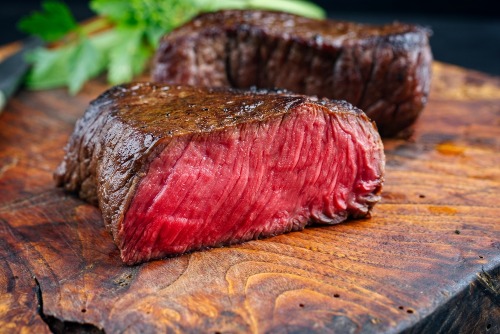 If you’re planning a big game hunting trip for buffalo at Rocky Mountain Elk Ranch, you’re in for an exciting adventure. But after the hunt, knowing how to cook buffalo meat properly is just as important as bringing home your trophy. Buffalo, or bison, is leaner than beef, requiring a different approach in the kitchen to ensure it’s tender and flavorful. Here’s what you need to know to maximize your wild game cooking experience.
If you’re planning a big game hunting trip for buffalo at Rocky Mountain Elk Ranch, you’re in for an exciting adventure. But after the hunt, knowing how to cook buffalo meat properly is just as important as bringing home your trophy. Buffalo, or bison, is leaner than beef, requiring a different approach in the kitchen to ensure it’s tender and flavorful. Here’s what you need to know to maximize your wild game cooking experience.
The Basics of How to Cook Buffalo Meat
Buffalo meat is naturally lower in fat and calories than beef, making it a healthy and delicious option. However, this also means it can dry out quickly if overcooked. Whether you’re preparing steaks, burgers, or a roast, knowing how to cook buffalo meat correctly will ensure your well-earned meal is as enjoyable as the hunt.
Cook Low and Slow
One of the most important things to remember when preparing buffalo is that it requires a gentle touch. Because buffalo meat is so lean, it benefits from lower cooking temperatures and slower cooking times, especially for larger cuts like roasts or briskets. Braising or slow-roasting helps maintain moisture, resulting in tender, flavorful meat. For quicker cooking methods like grilling, keeping the heat medium rather than high will prevent the meat from drying out.
Avoid Overcooking
Buffalo cooks faster than beef, so it’s easy to overdo it, so be careful. Aiming for medium-rare to medium doneness, or around 135°F to 145°F internal temperature, is key. Anything beyond this will cause the meat to lose moisture and become tough. If you’re cooking steaks, use a meat thermometer to avoid guesswork and pull them off the heat slightly before they reach your target temperature, as they will continue to cook while resting.
Use Marinades to Add Flavor
Another great tip for learning how to cook buffalo meat is to use a marinade. A well-chosen marinade can enhance the flavor and help tenderize the meat. Since buffalo lacks the fat that helps keep beef juicy, a marinade with an acidic base—like vinegar, wine, or citrus juice—can break down the muscle fibers and add moisture. Try marinating your buffalo steaks or roasts for several hours or overnight for the best results.
Add Fat if Necessary
Since buffalo meat is so lean, you should introduce extra fat into your recipes to keep the meat juicy and flavorful. When grilling buffalo burgers or cooking steaks, adding a small amount of oil, butter, or bacon fat can enhance the texture and taste; this is especially helpful for ground buffalo, which tends to be much leaner than ground beef. A touch of fat can make a notable difference when preparing these leaner cuts.
Let the Meat Rest
After cooking, one of the most overlooked steps is letting the meat rest. Whether you’ve grilled a steak or roasted a larger cut, allowing the meat to sit for 5 to 10 minutes before slicing helps the juices redistribute throughout the meat. Skipping this step can cause the juices to escape, leaving your buffalo meat drier than expected. Taking a few minutes to let it rest will give you a more tender, flavorful bite every time.
Idaho’s Premier Ranch for Elk and Buffalo Hunts
Cooking buffalo meat requires more attention than traditional beef, but it can be a delicious and healthy alternative with the right techniques. Whether you’re preparing steaks, burgers, or a slow-cooked roast, knowing how to cook buffalo meat properly will elevate your wild game meals. As you plan your big game hunting trip at Rocky Mountain Elk Ranch, ensure you’re ready for the hunt and the following feast. Embrace these tips, and your buffalo meals will be a flavorful reminder of your hunting adventure in Southeast Idaho.
